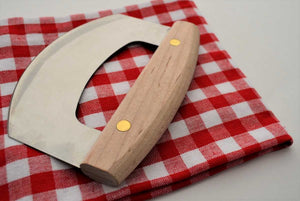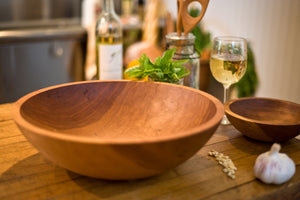- Continue Shopping
- Your Cart is Empty
A Chopped Salad Bowl Holds a Symphony of Salad Greens
 Think of your chopped salad as if you were composing a piece of music, and think about your artful arrangement of chopped greens and vegetables in a beautiful chopped salad bowl.
Think of your chopped salad as if you were composing a piece of music, and think about your artful arrangement of chopped greens and vegetables in a beautiful chopped salad bowl.
Imagine how strange classical music would sound if the full orchestra never played at the same time. The cellos might play their lonely part alone for awhile, followed by a discordant combination of violins and timpani that then yielded to a odd trumpet solo—but what you would never hear was the rich, interwoven sound of all the instruments, performing together in one perfect song.
That’s the difference between a chopped salad and other salads. In composed salads and layered salads, you taste first one ingredient, then another, but you never know the sensation of all ingredients simultaneously. In a tossed salad, you may taste two or even several ingredients at a time, but rarely are all present in each mouthful, and the proportion of flavors varies widely from bite to bite.
But a well-made chopped salad presents you with a harmonious, balanced combination of sweet, salty, sour, and bitter flavors every time. It takes a bit more work to create a fine chopped salad, just as it takes work to create a symphony—but the result is beautifully worth it.
Start your chopped salad with seasonal fresh fruits and vegetables. Choose a variety of textures, and vary the size of the ingredients so that each complements, but does not overpower, the others. (Avoid the temptation to use up leftovers from your refrigerator. Quality ingredients are a must!) You can invent your own chopped salads, experimenting with differing combinations of ingredients in varying proportions, or you can play it safe by following a recipe—like this great salad from the Food Network, or this tasty recipe for a Waldorf salad.
To save time and protect your fingers as you work, we recommend you invest in these two tools:
- A chop-quality wooden bowl. Chopped salads require a lot of slicing and dicing, and it can be dangerous to hold ingredients still just millimeters from a sharp, moving knife. If you chop in a wooden bowl, though, the sloping sides keep ingredients falling back to the center as you work, and you won’t lose time chasing what you’ve chopped as it rolls all over a flat cutting board (or even onto the floor). We recommend using a bowl that’s 9-12 inches in diameter and easy to hold—like this one, which makes a great kitchen workhorse.
- A mezzaluna. The second tool you’ll need is a special knife called a mezzaluna—an Italian word for “half moon” that refers to the knife’s curved blade. We include a mezzaluna with the chop bowl mentioned above because it not only cuts down preparation time, it keeps your fingers safely above the active blade. (If you’ve never used a mezzaluna before, it may help to practice with it on a flat cutting board until you can chop with a gentle, rocking motion.)
You can use your mezzaluna on almost anything—herbs, nuts, meats, cheese, olives, tomatoes, cranberries, even as a pastry knife—and once you get the hang of it, you may never want to use an ordinary knife again.
Now that you know the basics, it’s time to create your own symphony in salad. Just remember to chop powerful ingredients (like garlic or onion) finely, so they are lightly present in each bite, and chop subtle ingredients (like romaine lettuce) in large squares. That way, each ingredient will contribute its own distinctive note to every mouthful.

from

Mezzaluna Salad Chopper Curved Blade Traditional Mezzaluna Design
from $ 39.99

Cherry Wood Salad Bowl 12" (Serves 4) Free Shipping
from $ 129.99
>div






